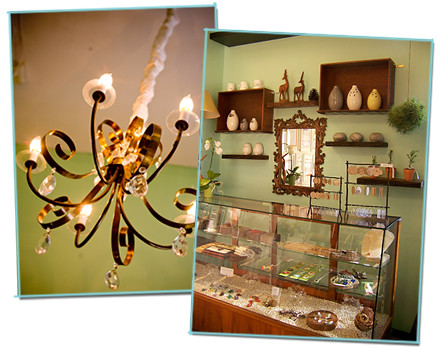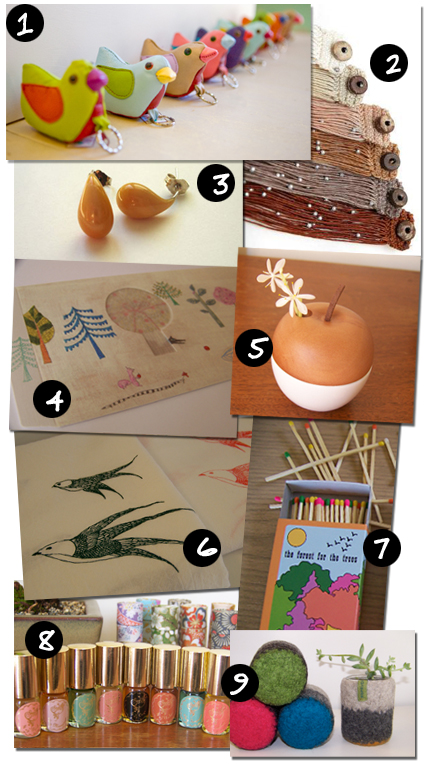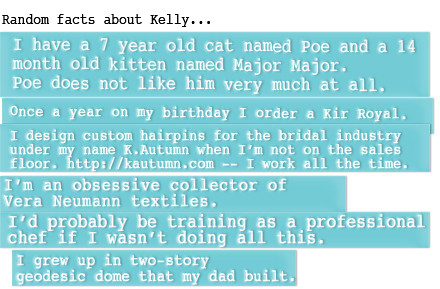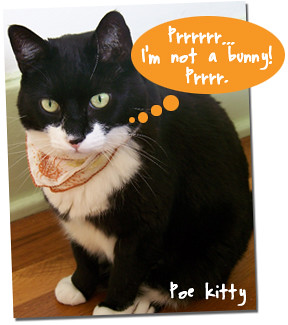Retail Therapy: Relish at Home

 I just wanted to give Kelly a huge thank you hug for this interview... two years ago I was planning to open up a shop and I came across an article about Relish at Home while researching/planning. I had tons of questions and was dying to talk to someone who had some first-hand knowledge, so I decided to send her an email. I was a bit nervous and sorta felt like I was harassing a complete stranger, but I figured the worst that could happen is that she says no. Well the complete opposite happened. Kelly graciously suggested that I give her a call one Saturday afternoon so we could chat about owning a shop! Although I didn't end up opening a shop, I never forgot about Kelly and Relish at Home - I've been dying to get her on the site since I started the Retail Therapy series. Oh and please be sure to bookmark www.relishathome.com - Kelly will be launching the online store in early 2009!!! Can't wait!
I just wanted to give Kelly a huge thank you hug for this interview... two years ago I was planning to open up a shop and I came across an article about Relish at Home while researching/planning. I had tons of questions and was dying to talk to someone who had some first-hand knowledge, so I decided to send her an email. I was a bit nervous and sorta felt like I was harassing a complete stranger, but I figured the worst that could happen is that she says no. Well the complete opposite happened. Kelly graciously suggested that I give her a call one Saturday afternoon so we could chat about owning a shop! Although I didn't end up opening a shop, I never forgot about Kelly and Relish at Home - I've been dying to get her on the site since I started the Retail Therapy series. Oh and please be sure to bookmark www.relishathome.com - Kelly will be launching the online store in early 2009!!! Can't wait!
And true to form, her answers are outstanding and super super useful. So, to all aspiring store owners out there - get your bookmark buttons and printers ready...
Quick Facts:
# of employees: 1 (all me), plus a couple of extra hands during busy times.
Did you write a business plan? Yes, sort of.
Day your doors opened: September 2005
Owner: Kelly Sperbeck
www.relishathome.com
>> Think you're ready to open up a shop? Read on and find out what really goes on behind the register...
1.Name one thing that completely took you by surprise when you first started Relish at Home - something that neither biz how-to books or any "SCORE" workshop prepared you for.
How difficult it is to secure funding. Nowadays most banks won’t even talk to you unless you’ve been in business for a minimum of 2 years. It’s pretty daunting considering most businesses don’t show a profit for two years. How in the world is a small business supposed to get their foot in the door and survive without help in the beginning? I found that it was essential to begin with a chunk of personal savings (although some financial experts would argue self financing is a black hole.) Probably the most surprising moment was when my banking officer flat out told me that credit card companies would offer a better interest rate for a loan than my bank would -- and that they’d been telling small business owners that for years... Say what?
>> click here to continue reading about Relish at Home
2. How did you come up with the name "Relish at Home"? Can you share 3 other names that were close runner ups or ones that would have been disastrous in hindsight?
There were many ideas tossed around, but I seem to only remember a close call with “Pocketshop.” We couldn’t use that one though because the trademark belongs to a software program. Relish at Home just stuck because it described exactly what we were doing with our business model.
Relish at Home actually has a long history of evolution. In 2004, the original business model was a home based venture which focused solely on bringing handmade accessories to home trunk shows and special events. My partner and I at the time felt “Relish at Home” was the perfect description of what we were bringing to the table... An opportunity for customers to enjoy unique, handmade products at home. About a year later, when we were looking for an office, we found a special location in West Berkeley called “Activspace.” Before we knew it, our original idea for an office/stockroom had evolved into a boutique. We decided to keep the name because our brand identity had become recognized in the area. Many of our clients who hosted and attended our trunk shows started coming by to shop the boutique. Ironically, the shop is literally the size of a pocket and tiny at just under 400 square feet!

Kelly is currently working on her site and is planning to launch the online shop early in 2009. In the meantime, you can place your order for any of these items by calling 510-981-9400 or 877-3-relish or email info@relishathome.com. And Kelly is offering free domestic shipping for any of the above items through 11/30, just mention Heart Handmade!!
1. Relish At Home scrappy leather bird keychains $10 (house design product)
2. Tessapoppy Design - Wikkitz bracelets $20
3. Verre NY Ulala glass studs $59
4. Japanese forest shadowbox birthday card $7
5. Japanese wooden apple vase $18
6. Flock Home hand-screened cotton tea towels $8
7. Sage perfume oils - $45 (I wear the original green sage scent everyday!)
7. Papaver Vert felted bud vases $20
8. Relish At Home color-tip matchboxes $5 (house design product)
3. You've been in business 2005 - was there a year where you felt some kind of sigh of relief and felt confident that you weren't going to be part of a statistic? They say that in the restaurant business, you shouldn't expect to see any profit until your second year - is it the same for retail in your experience? What should aspiring store owners be prepared to expect?
My “ta dah” moment was actually not until 2007 after my partner officially left the business and I was completely on my own. I renovated the boutique to include a wall for featured artists and decided to do away with apparel for lack of space. I overhauled the inventory and made the choice to focus on home accessories, ceramics, and double my jewelry and stationery collections. It really made sense and solidified my vision for the company. When the holidays came I hit the ground running and I was so amazed at the outpouring of support from customers and designers far and wide. I was totally re-energized and everything suddenly clicked for me. I really believe that was my make it or break it moment.
It’s just a different time now to be in business. There are so many new factors to consider like product value and sustainability. I think new store owners almost have an advantage because they might already be aware of the frailty of the retail market and don’t have anything to compare it to. For those of us who’ve been around the block a few times, it’s a time to stay flexible and positive that things will turn around. 4. They say that "A business that doesn't grow eventually dies..." How has Relish at Home evolved since you first opened your doors back in 2005?
4. They say that "A business that doesn't grow eventually dies..." How has Relish at Home evolved since you first opened your doors back in 2005?
As mentioned earlier, the company was a completely different idea when it was conceived. Phase one was the trunk shows. Phase two has been the boutique, and now phase three is the online store which has been an ongoing work in progress. I hope to launch very soon! It’s difficult to juggle so many things at once. There has never been a dull moment. Somewhere in there I blur the lines and manage to design products in between. I have always hoped to fully integrate a wholesale division for Relish at Home and go back to my roots as a FT designer. The evolution is ongoing...
5. You once had a business partner, can you please share some words of wisdom on "to partner" or "not to partner"? What factors should one consider when deciding whether or not to go into business with a partner?
Having a partner can be the best thing ever considering there are so many hats to wear in owning a business, but choose wisely especially if you go into business with friends. My experience was a rocky one even though I thought I was following my heart. It’s general knowledge that few friendships are able to survive a business partnership let alone a dissolution of one amicably. Here are some tips if you are thinking about going into business with a partner:
One partner should always assume the lead. Even though duties are split, if there’s a deadlock over something, one partner needs to be the deciding factor. When that happens what do you do? That’s why it’s helpful to have a varied percentage of ownership such as 51/49, 60/40, 55/45, etc...
Read about the legalities of incorporating, general partnership vs. LLC, etc... in all the business books. It’s very important to notarize documents and maintain good records of anything relating to your partnership.
Have regular heart to heart talks and keep the lines of communication open. It will lessen any frustrations you have with each other later. Be very clear about all the good and the bad stuff that nobody wants to talk about in addition to your goals for the company. It’s inevitable that ideas and growth will be re-evaluated and life happens, people change and you must be prepared for many scenarios.
Lastly, follow your heart, BUT listen to your instincts. Make sure the partner you chose is capable of towing the line and has the businesses best interest at heart. Are they as passionate as you? Are they willing to work as hard as you? What are their needs? Also consider their partners (if they are married or have children) because those people are their responsibilities too and ultimately those relationships factor into your business relationship.
6. Do you have a magical buying formula? Can you please share 3 things you learned about buying and deciding how much inventory to purchase for the very first time.
Inventory is the biggest headache of all. I have always had one big rule -- which is I never bring anything into the store that I personally wouldn’t wear, give someone as a gift, or have in my home. Don’t solely buy into trends. I think it’s so important for a store owner to be passionate about what they sell otherwise customers can tell you’re just not that interested.
I learned a very valuable lesson early on about re-ordering. It can really be a catch 22. My rule of thumb is to never re-order trend products. Chances are when you receive your next shipment, it’s over with and you’ll be stuck with the merchandise. Besides there is always something new around the corner and the product life cycle moves quickly. Most businesses are built on repeat clientele. Unless your business is completely based on tourism, you will likely have a higher ratio of repeat customers, to new. My breakdown feels like it’s around 65/35.
Lastly, I learned that if you believe in a product, it’s very important for you to buy into it in order to give it a real shot. I love it when vendors are flexible with minimums and I try to order 3 or more per style (unless the item is special & pricey) otherwise it’s hard to tell which of the styles sells the best. You can’t tell from 1, and rarely can you tell from 2. You have to be patient too. As frustrating as it may be, sometimes it takes a few weeks for clients to catch on to new products.
>> So you think your goods are perfect for Relish at Home?
7. Do most of the other designers you carry approach you, or do you actively seek out new designers/crafters? If so, where?
I work on consignment with many new designers, as well as purchase goods for specific categories. About 50% of what I carry in the boutique is designed locally. Many designers who are outside the Bay area contact me over email. I juggle a few different hats and outside design projects so I don’t have a lot of time to shop, and it’s often difficult for me to spend hours pouring through links or Etsy sites. I rely heavily on local events where I can connect with designers in person and I also manage a trip to NY once or twice a year. I have also formed many new positive relationships with designers through their friends who visit the store and tell me how fabulous their friend’s work is... so I check it out. My business has largely been successful through word of mouth, so I like that some of that comes back to me in finding new designers.
8. What is your process in choosing merchandise and what 3 things can artists do to stand out in your mind?
I usually draw from my experience as a rep (I repped accessories lines for 2 years before opening the shop FT) mixed with the instincts I have about my clientele and the designers I meet. I have to limit what I bring into the store due to the space restrictions and the fact that my store is a destination shop without the standard walk-by traffic most stores rely on. I choose based on price point & value mixed with wearability & originality. It’s a struggle to find the marriage between all of those factors. Plus I’m in Berkeley and it’s an entirely different universe out here sometimes...
Know your targeted business and approach stores who carry “simpatico” lines with yours. More than likely they will be interested in taking a look at your work. Don’t be pushy and make sure to give shop owners time before you follow up too. Often times they’re running behind on everything!
Practice good territory karma. If you’re an emerging designer in demand, shop owners appreciate being notified if neighboring stores or competitors start inquiring about your wares. Stay loyal to your accounts by offering them the opportunity to place re-orders on new styles first before you jump to new stores. It’s a tricky topic, but important to navigate this sea with ease...
Lastly, spend the time to develop your brand identity. I meet so many talented designers who don’t take the time to develop hangtags, or business identity on their products. I think it can make or break a product. It’s essential and worth the investment because shoppers want to have a relationship with most of the products they purchase. They identify with the designer and want to know where it comes from, how it was made and who to contact if they want more!
9. Owning a shop means constantly wearing different hats. Here's how Kelly ends up spending her time:
Buying 10%
Marketing & Promo 10%
Production & Operations 10%
Customer Service 50%
Fulfillment/Shipping 2%
Acctg/Billing/consignment 10%
Other (Designing) 8% 10. If Oprah decided to give you $10,000 tax free for your business, but you had to spend it in one week, what would you do with it?
10. If Oprah decided to give you $10,000 tax free for your business, but you had to spend it in one week, what would you do with it?
After I paid some bills I would save the rest for production & design towards some of the work I’ve had on hold under the house label. I would also be sure to donate a percentage to my community charities. I’m a yearly supporter of Project Open Hand East Bay. I think it’s really important to give back where you can because sending out positive energy only radiates more and we all know the world can use a lot more of that!
11. What has been the most challenging thing you've faced since starting your business?
I survived an IRS audit in the middle of my store being remodeled. Being audited is every small business owner’s worst nightmare. There’s such a stigma around it, but the experience changed me. It was one of those truly super-human moments where you either completely crash and throw in the towel, or you get up and begin again. I was lucky because mine was a positive one with a positive outcome despite the months of agony and paperwork. The experience was monumental in teaching me to be a stronger business person, and really showed me who my true friends and supporters were. Now that some time has passed, I talk about it more openly because I hope to assure other designers and small business owners to confront their fears and believe in their ability to be strong businesspeople. It’s important to stand up for your business and be informed. Always know your rights, and don’t forget to maintain good records.
>> LINKS
http://www.relishathome.com
http://www.kautumn.com
>> VISIT
Relish At Home. 2703 Seventh St., At Parade Street, Berkeley, CA, 94710. (510) 981-9400
Thanks Kelly!!


3 comments:
Oh, how I wish I were closer! I would love to visit Kelly's shop. I think I'd be a regular there! Thanks for introducing her shop to me--I'm looking forward to the online debut!
Amy
Wonderful interview! I wish I could visit her actual shop. :)
What a fantastic shop! Just beautiful! I cannot wait until Kelly launches her online store! I will be looking forward to it!
xo
Melis
Post a Comment